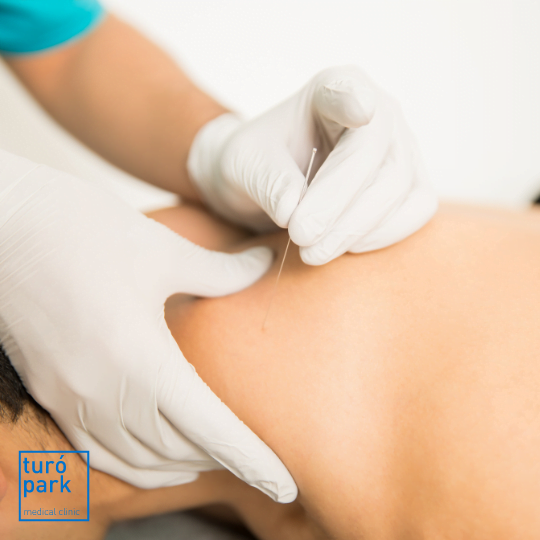Try the minimally invasive and effective dry needling technique to relieve muscle tension with our English-speaking physiotherapists in Barcelona!
Increasingly used by physiotherapists, this technique relieves pain caused by muscle contractures, stimulates blood circulation and promotes flexibility and relaxation.
If you suffer from painful muscle tension, don't hesitate to make an appointment with one of our physiotherapists to benefit from the dry needling technique.
Do not hesitate to make an appointment now with our physiotherapist.
Fast track your treatment
To book an appointment or speak with one of our friendly team, please get in touch using the options below.

How does dry needling work?
The dry needling technique, also known as trigger point dry needling, consists of inserting very fine needles directly into the point of origin of a muscular tension, which are called trigger points.
Muscles sometimes develop knotted areas called trigger points, that cause discomfort and pain. The physiotherapist discerns the location of these trigger points by putting slight pressures onto the areas of muscle pain, after which it is essential to act with precision.
The use of needles reactivates the supply of oxygen to the contracted muscle fibre and fascia, reduces the inflammatory reaction, improves vascularisation and thus releases the tension in a lasting way.
Finally, the needles are used to stimulate the tissue, not to inject medication. It does not use any medicinal substances and unlike acupuncture, it does not act on the meridians and does not aim to improve the energy flow in the body.
Who is the dry needling technique for?
It is a minimally invasive treatment used for acute and chronic pain, post-traumatic injuries and overuse injuries.
Specifically, it appears to have very positive results in tendinopathy, scar pain, soft tissue treatment, acute muscle contractures, lumbago and Myofascial Pain Syndrome (MPS).
Are there any contraindications to dry needling?
Dry needling is not recommended in case of:
- Bleeding disorders
- Compromised immune system
- Diabetes
- Epilepsy
- Lymphoedema
- Vascular disease
- Pregnancy
- Needle phobia
- Anticoagulant therapy
Similarly, treatment can be counterproductive if the patient is uncooperative or lacks understanding in the reasons for the specific nature of the treatment.
Dry needling: risks and side effects
The treatment is generally very fast and lasts less than a minute per trigger point. To avoid any risk of complications, the physiotherapist follows the most recent and established recommendations regarding hygiene and disinfection.
Nevertheless some side effects may occur after the session, including:
- Pain during or after the procedure
- Bleeding at the site where the needles were inserted
- Fainting
- Fatigue
- Bruising of the skin
Most of these side effects are minor and do not cause significant injury to patients undergoing the treatment.
Healthy Body, Healthy Mind!
Our English-speaking physiotherapists welcome you for the treatment of your pain and the rehabilitation of your injuries.

What to expect from your dry needling session at Turó Park Medical Clinic?
Firstly, during your consultation with a physiotherapist at Turó Park Medical Clinic, the practitioner will first check for possible contraindications to the treatment, identify painful areas and trigger points, and then plan the procedure.
The puncture will be carried out using sterile single-use needles and a specific disinfection solution to ensure optimal hygiene conditions.
During the treatment, the physiotherapist will place needles in the trigger points in order to cause a muscle jolt to allow the blood flow to return. The needle is inserted into the skin above a trigger point only 5 mm to 10 mm deep for 30 seconds.
Moreover, during the procedure, you may feel some muscle pain, muscle twitching or soreness. These sensations are considered a good sign that your muscles are responding to the needle insertion.
After the treatment, it is advisable to drink plenty of water and avoid strenuous exercise.
Our English-speaking physiotherapists
